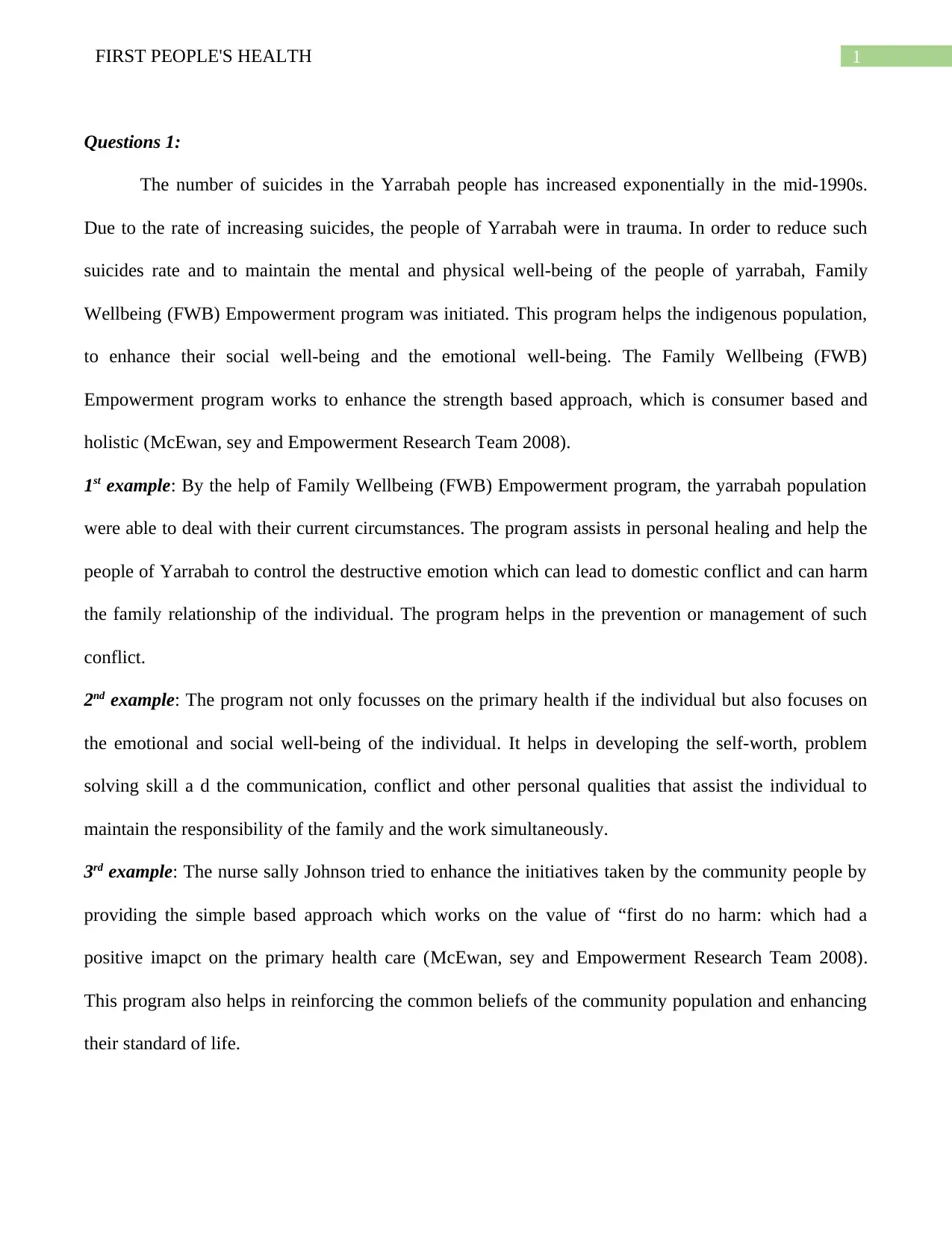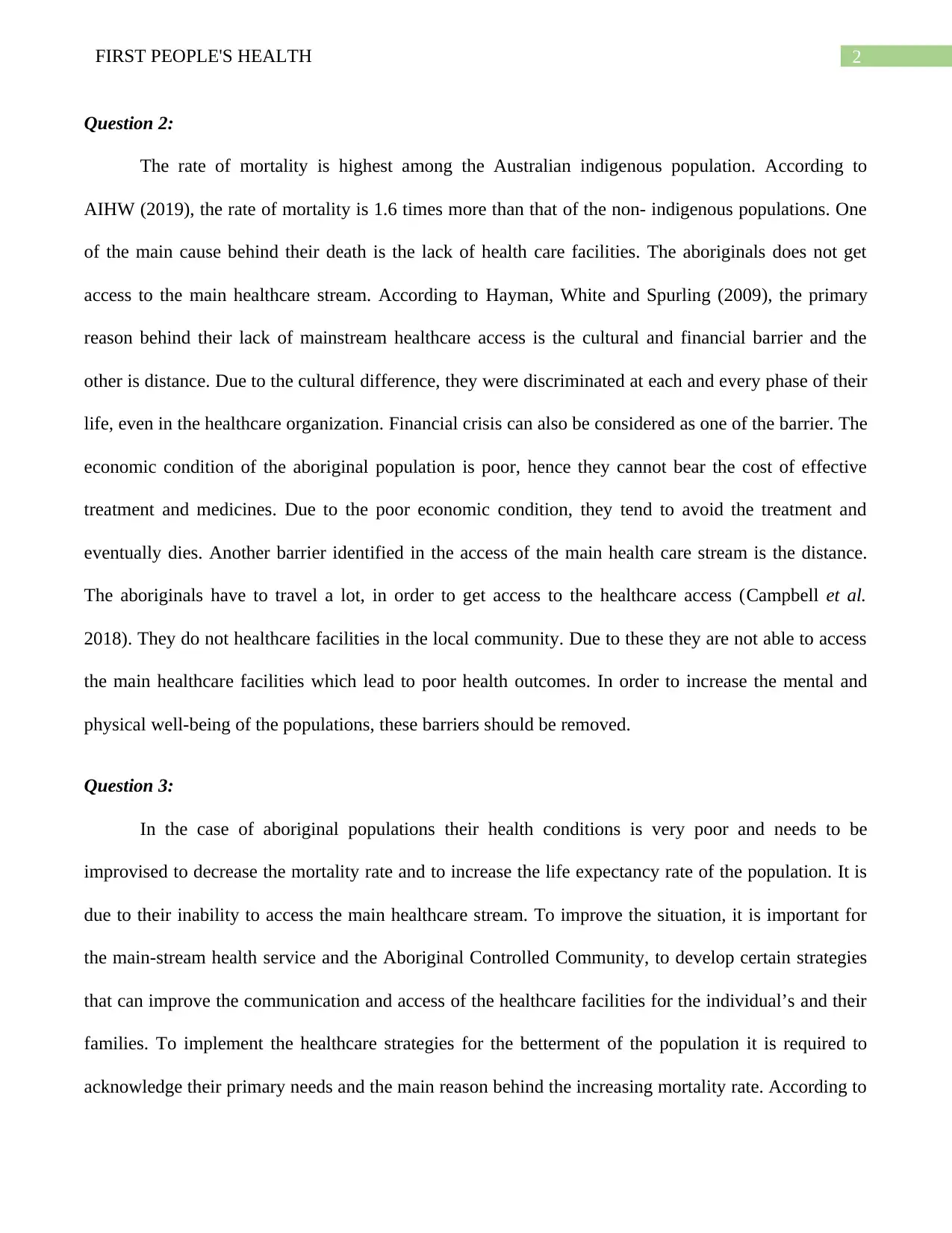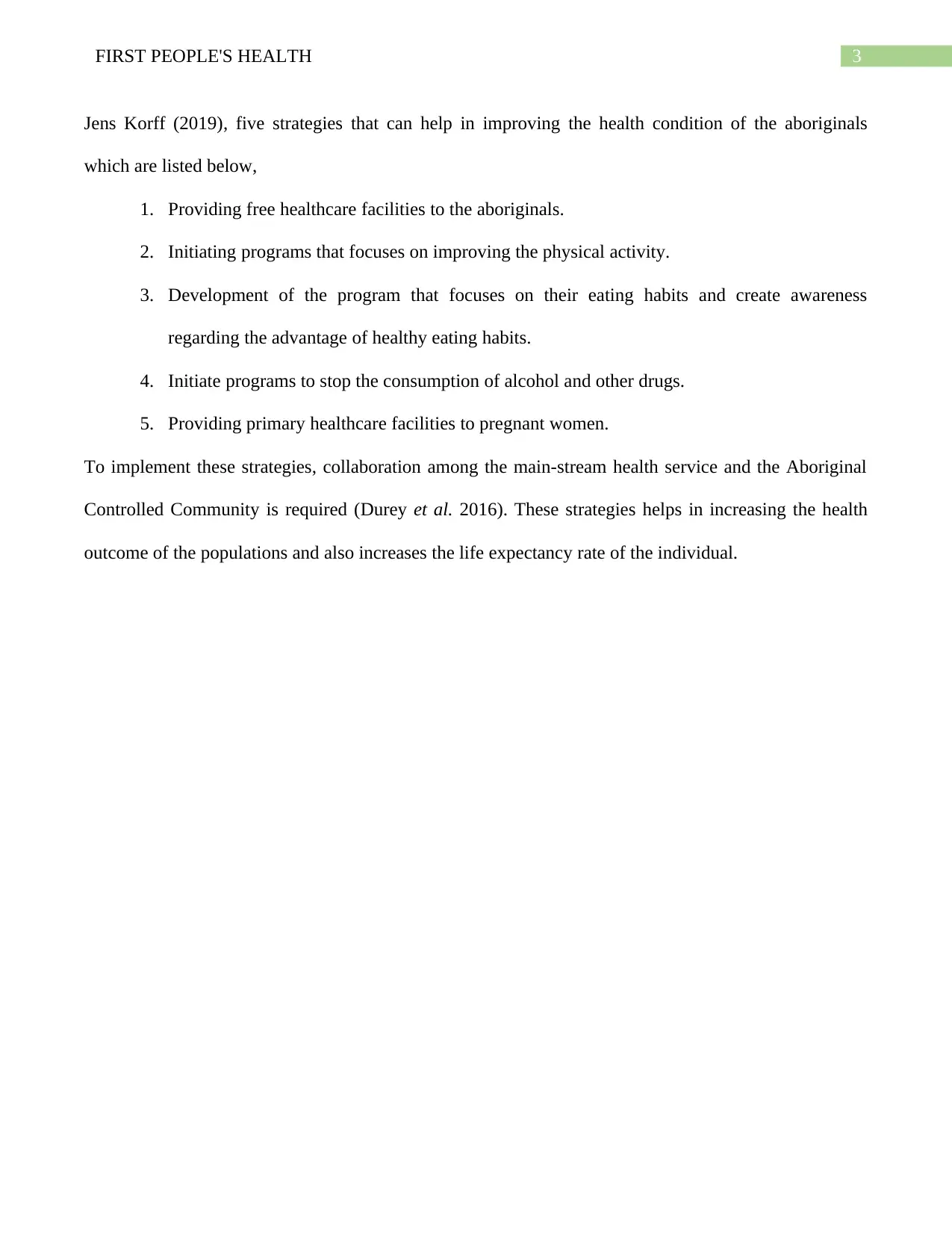First Peoples Health: Yarrabah Program Case Study Analysis
VerifiedAdded on 2023/01/20
|5
|1157
|100
Case Study
AI Summary
This case study examines the First Peoples Health, focusing on the Yarrabah Family Wellbeing (FWB) Empowerment Program, initiated to address the rising suicide rates and improve the mental and physical well-being of the Yarrabah people. The program utilizes a strength-based, consumer-centered, and holistic approach, aiding individuals in managing destructive emotions, resolving conflicts, and enhancing self-worth. The study also explores the barriers to mainstream healthcare access for Aboriginal Australians, including cultural, financial, and geographical challenges, leading to poorer health outcomes. To improve healthcare access and health outcomes, the study proposes strategies such as free healthcare, programs promoting physical activity and healthy eating, and initiatives to reduce substance abuse, along with collaboration between mainstream health services and Aboriginal-controlled community health services.

Running head: FIRST PEOPLE'S HEALTH
FIRST PEOPLE'S HEALTH
Name of the student:
Name of the university:
Author note:
FIRST PEOPLE'S HEALTH
Name of the student:
Name of the university:
Author note:
Paraphrase This Document
Need a fresh take? Get an instant paraphrase of this document with our AI Paraphraser

1FIRST PEOPLE'S HEALTH
Questions 1:
The number of suicides in the Yarrabah people has increased exponentially in the mid-1990s.
Due to the rate of increasing suicides, the people of Yarrabah were in trauma. In order to reduce such
suicides rate and to maintain the mental and physical well-being of the people of yarrabah, Family
Wellbeing (FWB) Empowerment program was initiated. This program helps the indigenous population,
to enhance their social well-being and the emotional well-being. The Family Wellbeing (FWB)
Empowerment program works to enhance the strength based approach, which is consumer based and
holistic (McEwan, sey and Empowerment Research Team 2008).
1st example: By the help of Family Wellbeing (FWB) Empowerment program, the yarrabah population
were able to deal with their current circumstances. The program assists in personal healing and help the
people of Yarrabah to control the destructive emotion which can lead to domestic conflict and can harm
the family relationship of the individual. The program helps in the prevention or management of such
conflict.
2nd example: The program not only focusses on the primary health if the individual but also focuses on
the emotional and social well-being of the individual. It helps in developing the self-worth, problem
solving skill a d the communication, conflict and other personal qualities that assist the individual to
maintain the responsibility of the family and the work simultaneously.
3rd example: The nurse sally Johnson tried to enhance the initiatives taken by the community people by
providing the simple based approach which works on the value of “first do no harm: which had a
positive imapct on the primary health care (McEwan, sey and Empowerment Research Team 2008).
This program also helps in reinforcing the common beliefs of the community population and enhancing
their standard of life.
Questions 1:
The number of suicides in the Yarrabah people has increased exponentially in the mid-1990s.
Due to the rate of increasing suicides, the people of Yarrabah were in trauma. In order to reduce such
suicides rate and to maintain the mental and physical well-being of the people of yarrabah, Family
Wellbeing (FWB) Empowerment program was initiated. This program helps the indigenous population,
to enhance their social well-being and the emotional well-being. The Family Wellbeing (FWB)
Empowerment program works to enhance the strength based approach, which is consumer based and
holistic (McEwan, sey and Empowerment Research Team 2008).
1st example: By the help of Family Wellbeing (FWB) Empowerment program, the yarrabah population
were able to deal with their current circumstances. The program assists in personal healing and help the
people of Yarrabah to control the destructive emotion which can lead to domestic conflict and can harm
the family relationship of the individual. The program helps in the prevention or management of such
conflict.
2nd example: The program not only focusses on the primary health if the individual but also focuses on
the emotional and social well-being of the individual. It helps in developing the self-worth, problem
solving skill a d the communication, conflict and other personal qualities that assist the individual to
maintain the responsibility of the family and the work simultaneously.
3rd example: The nurse sally Johnson tried to enhance the initiatives taken by the community people by
providing the simple based approach which works on the value of “first do no harm: which had a
positive imapct on the primary health care (McEwan, sey and Empowerment Research Team 2008).
This program also helps in reinforcing the common beliefs of the community population and enhancing
their standard of life.

2FIRST PEOPLE'S HEALTH
Question 2:
The rate of mortality is highest among the Australian indigenous population. According to
AIHW (2019), the rate of mortality is 1.6 times more than that of the non- indigenous populations. One
of the main cause behind their death is the lack of health care facilities. The aboriginals does not get
access to the main healthcare stream. According to Hayman, White and Spurling (2009), the primary
reason behind their lack of mainstream healthcare access is the cultural and financial barrier and the
other is distance. Due to the cultural difference, they were discriminated at each and every phase of their
life, even in the healthcare organization. Financial crisis can also be considered as one of the barrier. The
economic condition of the aboriginal population is poor, hence they cannot bear the cost of effective
treatment and medicines. Due to the poor economic condition, they tend to avoid the treatment and
eventually dies. Another barrier identified in the access of the main health care stream is the distance.
The aboriginals have to travel a lot, in order to get access to the healthcare access (Campbell et al.
2018). They do not healthcare facilities in the local community. Due to these they are not able to access
the main healthcare facilities which lead to poor health outcomes. In order to increase the mental and
physical well-being of the populations, these barriers should be removed.
Question 3:
In the case of aboriginal populations their health conditions is very poor and needs to be
improvised to decrease the mortality rate and to increase the life expectancy rate of the population. It is
due to their inability to access the main healthcare stream. To improve the situation, it is important for
the main-stream health service and the Aboriginal Controlled Community, to develop certain strategies
that can improve the communication and access of the healthcare facilities for the individual’s and their
families. To implement the healthcare strategies for the betterment of the population it is required to
acknowledge their primary needs and the main reason behind the increasing mortality rate. According to
Question 2:
The rate of mortality is highest among the Australian indigenous population. According to
AIHW (2019), the rate of mortality is 1.6 times more than that of the non- indigenous populations. One
of the main cause behind their death is the lack of health care facilities. The aboriginals does not get
access to the main healthcare stream. According to Hayman, White and Spurling (2009), the primary
reason behind their lack of mainstream healthcare access is the cultural and financial barrier and the
other is distance. Due to the cultural difference, they were discriminated at each and every phase of their
life, even in the healthcare organization. Financial crisis can also be considered as one of the barrier. The
economic condition of the aboriginal population is poor, hence they cannot bear the cost of effective
treatment and medicines. Due to the poor economic condition, they tend to avoid the treatment and
eventually dies. Another barrier identified in the access of the main health care stream is the distance.
The aboriginals have to travel a lot, in order to get access to the healthcare access (Campbell et al.
2018). They do not healthcare facilities in the local community. Due to these they are not able to access
the main healthcare facilities which lead to poor health outcomes. In order to increase the mental and
physical well-being of the populations, these barriers should be removed.
Question 3:
In the case of aboriginal populations their health conditions is very poor and needs to be
improvised to decrease the mortality rate and to increase the life expectancy rate of the population. It is
due to their inability to access the main healthcare stream. To improve the situation, it is important for
the main-stream health service and the Aboriginal Controlled Community, to develop certain strategies
that can improve the communication and access of the healthcare facilities for the individual’s and their
families. To implement the healthcare strategies for the betterment of the population it is required to
acknowledge their primary needs and the main reason behind the increasing mortality rate. According to
⊘ This is a preview!⊘
Do you want full access?
Subscribe today to unlock all pages.

Trusted by 1+ million students worldwide

3FIRST PEOPLE'S HEALTH
Jens Korff (2019), five strategies that can help in improving the health condition of the aboriginals
which are listed below,
1. Providing free healthcare facilities to the aboriginals.
2. Initiating programs that focuses on improving the physical activity.
3. Development of the program that focuses on their eating habits and create awareness
regarding the advantage of healthy eating habits.
4. Initiate programs to stop the consumption of alcohol and other drugs.
5. Providing primary healthcare facilities to pregnant women.
To implement these strategies, collaboration among the main-stream health service and the Aboriginal
Controlled Community is required (Durey et al. 2016). These strategies helps in increasing the health
outcome of the populations and also increases the life expectancy rate of the individual.
Jens Korff (2019), five strategies that can help in improving the health condition of the aboriginals
which are listed below,
1. Providing free healthcare facilities to the aboriginals.
2. Initiating programs that focuses on improving the physical activity.
3. Development of the program that focuses on their eating habits and create awareness
regarding the advantage of healthy eating habits.
4. Initiate programs to stop the consumption of alcohol and other drugs.
5. Providing primary healthcare facilities to pregnant women.
To implement these strategies, collaboration among the main-stream health service and the Aboriginal
Controlled Community is required (Durey et al. 2016). These strategies helps in increasing the health
outcome of the populations and also increases the life expectancy rate of the individual.
Paraphrase This Document
Need a fresh take? Get an instant paraphrase of this document with our AI Paraphraser

4FIRST PEOPLE'S HEALTH
References:
AIHW (2019). The health and welfare of Australia’s Aboriginal and Torres Strait Islander peoples:
2015, Life expectancy and mortality key points - Australian Institute of Health and Welfare. [online]
Australian Institute of Health and Welfare. Available at: https://www.aihw.gov.au/reports/indigenous-
health-welfare/indigenous-health-welfare-2015/contents/life-expectancy-and-mortality-key-points
[Accessed 7 Jun. 2019].
Campbell, M.A., Hunt, J., Scrimgeour, D.J., Davey, M. and Jones, V., 2018. Contribution of Aboriginal
Community-Controlled Health Services to improving Aboriginal health: an evidence review. Australian
health review, 42(2), pp.218-226.
Durey, A., McEvoy, S., Swift-Otero, V., Taylor, K., Katzenellenbogen, J. and Bessarab, D., 2016.
Improving healthcare for Aboriginal Australians through effective engagement between community and
health services. BMC health services research, 16(1), p.224.
Hayman, N.E., White, N.E. and Spurling, G.K., 2009. Improving Indigenous patients’ access to
mainstream health services: the Inala experience. Medical Journal of Australia, 190(10), pp.604-606.
Jens Korff, C. (2019). Successful Aboriginal health services. [online] Creative Spirits. Available at:
https://www.creativespirits.info/aboriginalculture/health/successful-aboriginal-health-
services#ixzz4dWswNiUX [Accessed 7 Jun. 2019].
McEwan, A., Tsey, K. and Empowerment Research Team, 2008. The role of spirituality in social and
emotional wellbeing initiatives: The family wellbeing program at Yarrabah. Cooperative Research
Centre for Aboriginal Health.
References:
AIHW (2019). The health and welfare of Australia’s Aboriginal and Torres Strait Islander peoples:
2015, Life expectancy and mortality key points - Australian Institute of Health and Welfare. [online]
Australian Institute of Health and Welfare. Available at: https://www.aihw.gov.au/reports/indigenous-
health-welfare/indigenous-health-welfare-2015/contents/life-expectancy-and-mortality-key-points
[Accessed 7 Jun. 2019].
Campbell, M.A., Hunt, J., Scrimgeour, D.J., Davey, M. and Jones, V., 2018. Contribution of Aboriginal
Community-Controlled Health Services to improving Aboriginal health: an evidence review. Australian
health review, 42(2), pp.218-226.
Durey, A., McEvoy, S., Swift-Otero, V., Taylor, K., Katzenellenbogen, J. and Bessarab, D., 2016.
Improving healthcare for Aboriginal Australians through effective engagement between community and
health services. BMC health services research, 16(1), p.224.
Hayman, N.E., White, N.E. and Spurling, G.K., 2009. Improving Indigenous patients’ access to
mainstream health services: the Inala experience. Medical Journal of Australia, 190(10), pp.604-606.
Jens Korff, C. (2019). Successful Aboriginal health services. [online] Creative Spirits. Available at:
https://www.creativespirits.info/aboriginalculture/health/successful-aboriginal-health-
services#ixzz4dWswNiUX [Accessed 7 Jun. 2019].
McEwan, A., Tsey, K. and Empowerment Research Team, 2008. The role of spirituality in social and
emotional wellbeing initiatives: The family wellbeing program at Yarrabah. Cooperative Research
Centre for Aboriginal Health.
1 out of 5
Related Documents
Your All-in-One AI-Powered Toolkit for Academic Success.
+13062052269
info@desklib.com
Available 24*7 on WhatsApp / Email
![[object Object]](/_next/static/media/star-bottom.7253800d.svg)
Unlock your academic potential
Copyright © 2020–2025 A2Z Services. All Rights Reserved. Developed and managed by ZUCOL.





